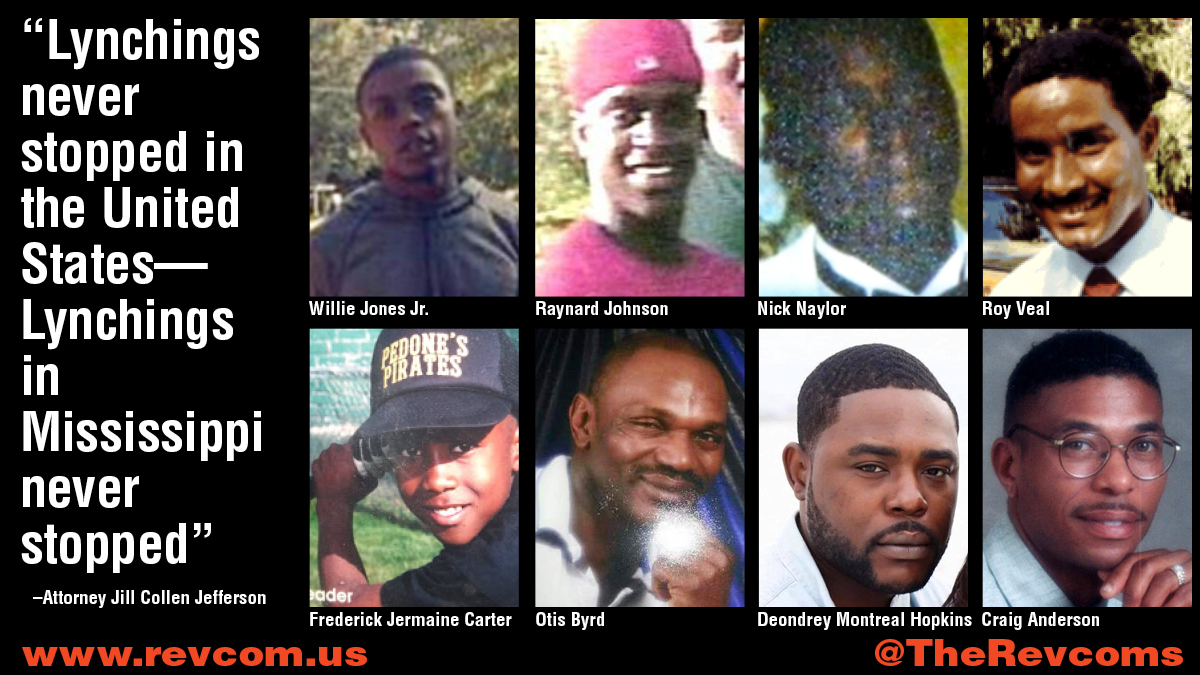Washington Post Reports on New Study:
Nightmarish Specter of Lynchings in Mississippi
| revcom.us
From a reader:
Between 1882 and 1968 there were 4,743 lynchings in this country according to data compiled by Tuskegee University.1 In the state of Mississippi, there were 581 lynchings between 1877 and 1950—more than in any other state. This includes the lynching of 14-year-old Emmett Till in 1955; the 1963 assassination of civil rights leader Medgar Evers; and the 1964 killings of three white civil rights workers—James Chaney, Andrew Goodman, and Michael Schwerner.
Now evidence has been found that since the year 2000 there have been at least eight lynchings of Black men in Mississippi alone, their bodies all found hanging from trees. In each of those eight cases the deaths were ruled suicides. But based on nearly five years of research and investigation Attorney Jill Collen Jefferson, founder of the civil rights law firm Julian Legal, believes all of these hangings were murders. As she told a Washington Post reporter: “lynchings never stopped in the United States. Lynchings in Mississippi never stopped. The evil bastards just stopped taking photographs and passing them around like baseball cards.”2
“There is a pattern to how these cases are investigated,” she found. “When authorities arrive on the scene of a hanging, it’s treated as a suicide almost immediately. The crime scene is not preserved. The investigation is shoddy. And then there is a formal ruling of suicide, despite evidence to the contrary. And the case is never heard from again unless someone brings it up.”

The 2018 death of Willie Jones Jr.
The body of a young Black man, 21-year-old Willie Andrew Jones Jr., was found hanging from a pecan tree the night of February 8, 2018, in front of his white girlfriend’s house in rural Scott County, Mississippi. There was a belt around his neck. Despite getting inconsistent stories from the 10 occupants about what happened before and after they found Jones’ body, and other conflicting evidence, Sheriff’s Department investigators decided 40 minutes after they arrived that Jones’ death was a suicide. Willie Jones’ mother, Tammy Townsend said, “They threw him away like he was nothing.”
Townsend challenged this conclusion. Willie’s four-month old son was inside the house that night. Prior to finding his body, Jones had argued with his girlfriend and her white stepfather, a racist who was opposed to interracial relationships, saying “It ain’t right in God’s eyes. There aren’t red birds and blue birds fucking out there.” The stepfather had threatened Jones with a gun, followed Jones when he went outside, and then claimed he’d found Jones’ body hanging from the tree.
In April of this year, a court awarded $11 million to the family of Willie Jones in a suit that accused the girlfriend, the stepfather, and several others of being directly or indirectly responsible for Jones’ death. Evidence from an independent investigation contradicted the initial ruling of suicide. That ruling ignored that grass was found in Jones’ hair, and in his wallet, consistent with him being dragged; and that his shoulder was dislocated. And the autopsy report listed the manner of death as “Undetermined.” In addition, four days before Jones’ death, the stepfather had threatened his life at the restaurant where his stepdaughter worked.
Two years earlier the stepfather had tried to kill another Black man—the father of the stepdaughter’s first child—with a broken bottle. The young man fled the scene, packed up, and moved out. When he heard about Jones’ death, court records show “he thought ‘That could have been me.’ Then he cried.” He was never interviewed by authorities. Jefferson now plans to approach the county to reopen the investigation.
Other possible victims of lynchings
The bodies of seven other Black men were found hanging from trees in Mississippi since 2000:
Raynard Johnson, 17, was found hanging from a pecan tree in his front yard in Kokomo, Mississippi, June 16, 2000. Rev. Jesse Jackson went to Mississippi to call for a serious investigation, leading a march to the spot where Johnson’s body was found hanging, saying “We reject the suicide theory.”
Nick Naylor, 23, was found hanging from a tree 11 miles from his house in Porterville, Mississippi, January 9, 2003, with a dog chain around his neck;
Roy Veal, 55, was found April 22, 2004, hanging from a pecan tree near Woodville, Mississippi, with a hood over his head. Veal had just returned to Mississippi to fight for his family’s land, and they believe he was murdered;
Frederick Jermaine Carter, 26, was found hanging from a tree limb in a white neighborhood in Greenwood, Mississippi. December 3, 2010. The state president of the NAACP said the community had “lost all confidence in the ability of local law enforcement to investigate” the hanging;
Otis Byrd, 54, had a bedsheet wrapped around his neck in Port Gibson, March 19, 2015;
Phillip Carroll, 22, found in Jackson, May 28, 2017. It was first reported that his hands had been tied behind his back, but that was later denied by the police;
Deondrey Montreal Hopkins, 35, found May 5, 2019 on a bank of Luxapalila Creek, is the most recent one found in Mississippi.
The 2011 lynching of Craig Anderson
In addition to these eight suspected lynchings, Craig Anderson, a 49-year-old Black man, was brutally lynched by a gang of 10 white teenagers, male and female, in a racial terrorist attack on June 26, 2011. Court records show the teenagers, who decided to “go f—k with some n——s,” found Anderson, beat him brutally, and then killed him by driving over him with a truck, while yelling “white power.” All of this was captured on a motel security camera. Eventually all 10 were indicted for conspiracy to commit several hate crimes against African Americans in Jackson from the spring of 2011 to March 2012. They each pleaded guilty, and received federal sentences.
Before sentencing three of the killers, Black U.S. District Court judge for the Southern District of Mississippi, Carlton Reeves, who grew up in rural Mississippi, gave a speech connecting the killing of Anderson to the state’s gruesome history. He told the courtroom these killers had resurrected “the nightmarish specter of lynchings and lynch mobs from the Mississippi we long forget.” They targeted Black neighborhoods in Jackson, he said, “for the sole purpose of harassing, terrorizing, physically assaulting and causing bodily injury to Black folk... They recruited and encouraged others to join in, and they boasted about their shameful activity,” Reeves said. “This was a 2011 version of the n—— hunts.”
“Mississippi has expressed its savagery in a number of ways throughout its history, slavery being the cruelest example,” Reeves said, “but a close second being Mississippi’s infatuation with lynchings.”3
White supremacy is sewn deeply into the fabric of this country, and with it the racial terror of lynchings used to enforce it. The findings that lynchings continue in 21st century America, and continue to be covered up, are intolerable.
1. Tuskegee University hosts ‘Lynchings and Liberators’ exhibition throughout February. [back]
2. ‘Lynchings in Mississippi never stopped,’ Deneen L. Brown, Washington Post, August 8, 2021 [back]
3. “A Black Mississippi Judge’s Breathtaking Speech To 3 White Murderers,” NPR Staff, February 13, 2015 [back]
"They're selling postcards of the hanging."
Bob Avakian, "Emmett Till and Jim Crow: Black people lived under a death sentence"
Now available as a PDF pamphlet:
Booklet | 8.5x11 sheets
Get a free email subscription to revcom.us:




